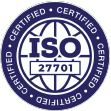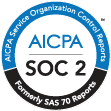From April 2025, employers across the UK will face a major change. The National Insurance Contributions (NIC) increase 2025 has come into effect, raising employer NIC rates from 13.8% to 15%. At the same time, the contribution threshold has dropped from £9,100 to £5,000.
This change, announced in the Autumn Budget 2024, aims to strengthen public services by increasing government revenue. However, it will add pressure on employers, especially those already working within tight budgets.
To stay competitive, businesses explore smart solutions like offshore staffing services, automation, and recruitment outsourcing solutions. These strategies help manage rising employment costs and maintain business agility.
What Are National Insurance Contributions (NICs)?
-
- National Insurance Contributions (NICs) are payments made by employees, employers, and self-employed individuals. These contributions fund state services like the NHS, pensions, and other benefits. Here’s how NICs work:
- Employees start paying NICs when they earn over £242 per week.
- Employers pay NICs for employees earning above the NIC threshold 2025 UK, now set at £5,000 annually.
- Self-employed people pay NICs based on their profits.
- NICs also determine eligibility for state benefits like the basic pension. With the National Insurance Contributions increase in 2025, businesses must now plan carefully to manage their growing obligations.
- National Insurance Contributions (NICs) are payments made by employees, employers, and self-employed individuals. These contributions fund state services like the NHS, pensions, and other benefits. Here’s how NICs work:
Why the Government Increased NICs?
The Autumn Budget 2024 introduced several tax changes, including the higher NIC rate. Chancellor Rachel Reeves explained the need to boost funding for healthcare, education, and other essential services. According to the Office for Budget Responsibility, the NIC increase is expected to raise between £23.8 billion and £25.7 billion annually over the next five years. This change helps strengthen public finances, but it also raises questions about how businesses can keep costs under control while continuing to grow.
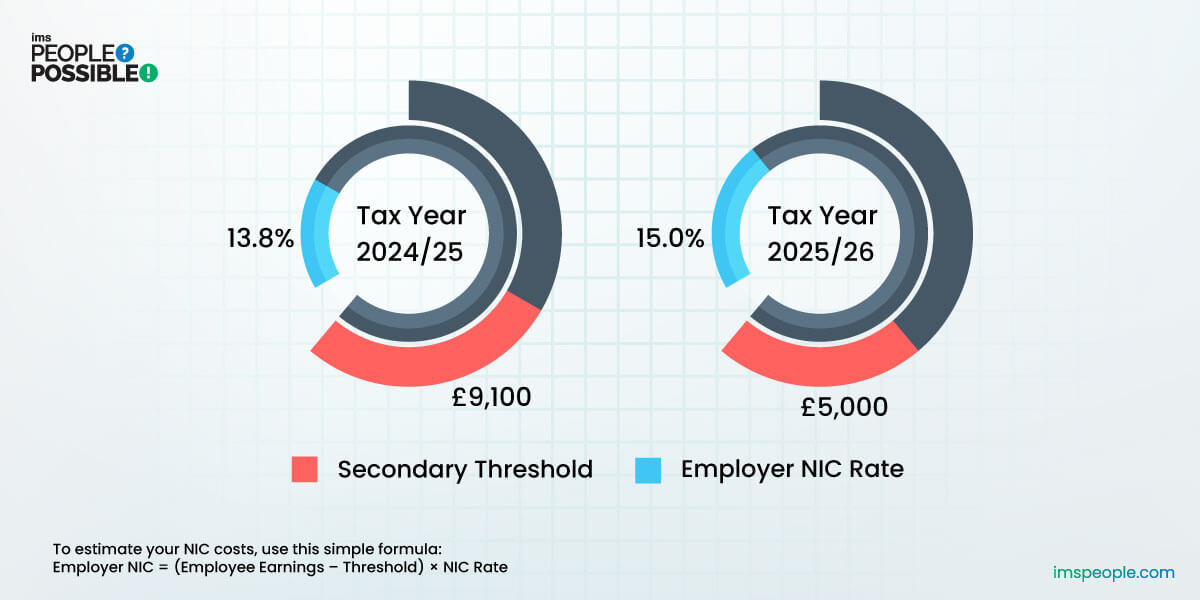
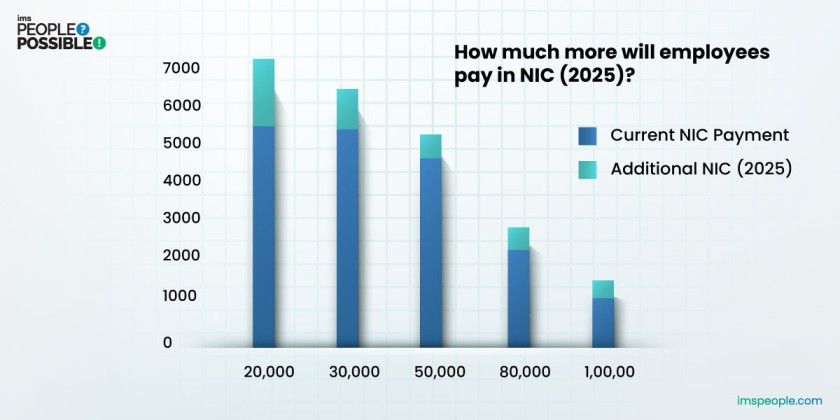
Who Is Most Affected by the 2025 NIC Rise?
The 2025 increase in national insurance contributions affects all employers, but some industries are under greater strain due to their workforce structure and cost sensitivity.
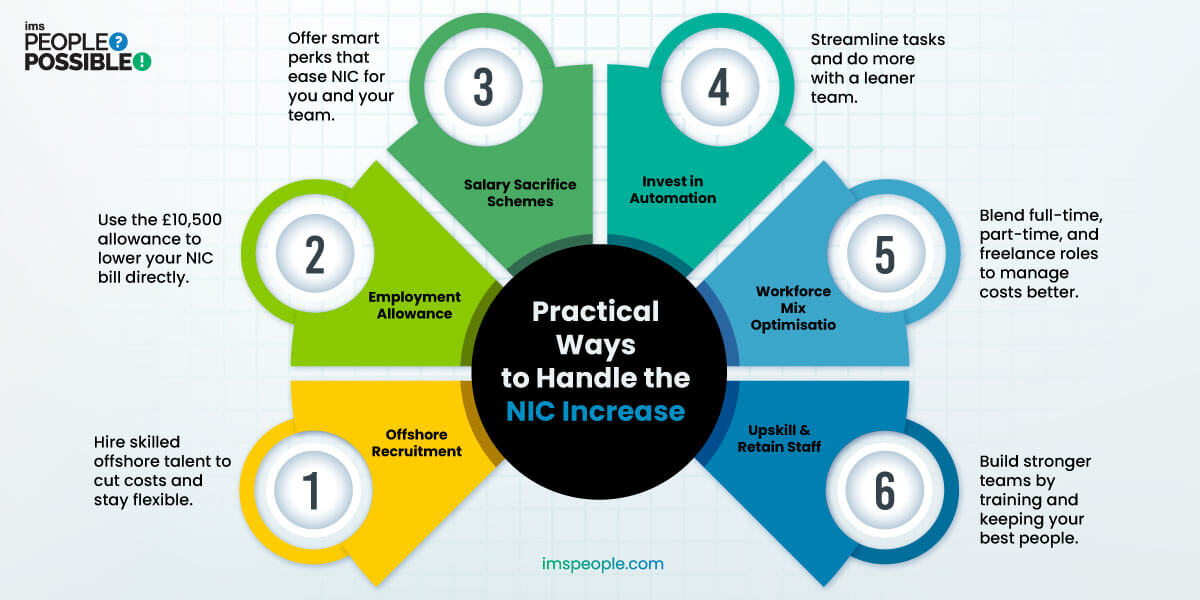
1. Retail and Hospitality
These sectors rely on large teams and already operate with thin profit margins. With higher NICs, many businesses may be forced to raise prices or cut roles to stay afloat. Two-thirds of top retailers could pass on the cost to consumers.
2. Healthcare and Social Care
These essential services are often government-funded and budget-constrained. The NIC hike puts added pressure on care providers, potentially affecting staffing levels and service delivery.
3. Construction and Contract-Based Work
Firms that work heavily with self-employed contractors may face indirect pressure, as rising employer costs may trickle down into reduced rates for subcontractors or limited engagement periods.
4. SMEs in Labour-Intensive Sectors
Smaller businesses in logistics, cleaning, and admin services are particularly vulnerable. Without large cash reserves, many will need to explore cost-saving options like offshore staffing services or recruitment outsourcing solutions to manage their workforce sustainably.
Practical Ways to Handle the NIC Increase
UK businesses are adopting practical and forward-thinking strategies to manage rising NIC costs. Here are six approaches that help ease the pressure:
1. Use Offshore Outsourcing for Recruitment
Outsourcing recruitment to offshore teams is one of the most effective ways to reduce costs. By working with trusted providers of offshore staffing services, companies can access skilled talent at a lower cost while staying flexible.
Offshore recruitment solutions UK businesses use allow them to scale quickly and maintain high-quality work without the added financial burden of local employment costs. It’s a smart move that aligns with modern, agile business needs.
2. Take Advantage of the Employment Allowance
The government has raised the Employment Allowance to £10,500. Eligible businesses can use this to reduce their national insurance bills directly. It’s a simple but important step in managing the impact of the NIC rise on UK businesses.
3. Offer Salary Sacrifice Benefits
Salary sacrifice schemes such as higher pension contributions or bike-to-work programmes – reduce the NIC burden for both employers and employees. This is a good example of cost-effective hiring strategies UK 2025 businesses can implement.
4. Invest in Automation
Automation and digital tools help businesses get more done with fewer people. By improving efficiency, companies can reduce their workforce size without losing productivity, helping them control their NIC expenses.
5. Optimise Your Workforce Mix
Review your staffing structure. A balanced mix of full-time, part-time, and freelance workers can help manage costs. This strategy is especially useful for reducing the employment costs UK businesses face under the new NIC rates.
6. Upskill and Retain Existing Employees
Training current staff increases productivity and reduces the need to hire frequently. Retaining talent saves money and builds stronger teams, a key part of recruitment cost-saving strategies UK employers should adopt.
How IMS People Possible Can Help Recruitment Businesses Navigate the NIC Increase?
Working with IMS People Possible, an offshore recruitment service provider, is a practical solution for UK staffing firms dealing with rising employment costs. We help the UK’s recruitment agencies reduce overheads and stay agile through expert offshore recruitment support.
From full-cycle recruiting and compliance to job order posting and out-of-hours cover, our offshore teams boost productivity while easing local employment costs.
Whether you’re a staffing firm in healthcare, IT, or commercial sectors, we help you stay competitive, compliant, and profitable.




